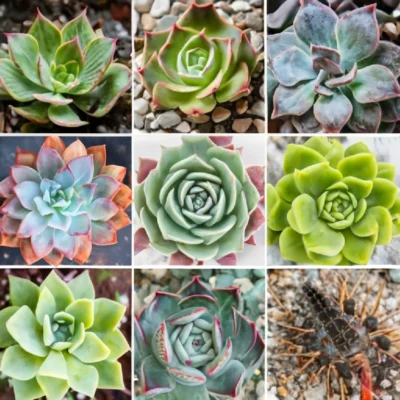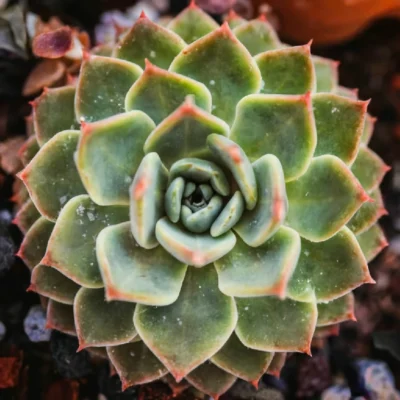Introduction to Succulent Pest and Disease Guide
Succulents are beloved for their low maintenance, unique beauty, and resilience. However, even these hardy plants can fall victim to pests and diseases. Understanding common problems and knowing how to address them can keep your succulents thriving. In this Succulent Pest and Disease Guide, we’ll explore the most common pests and diseases affecting succulents, and provide tips for prevention and treatment.
Common Succulent Pests
In the world of succulent care, even these hardy plants are not immune to pest problems. Our Succulent Pest and Disease Guide is here to help you identify and tackle the most common pests that can threaten your succulent collection. From tiny aphids to persistent spider mites, understanding these invaders is the first step in protecting your plants and ensuring they thrive.
1. Mealybugs
Identification: Mealybugs are small, white, cotton-like insects often found in clusters on the undersides of leaves and stems.
Damage: These pests suck the sap from succulents, causing leaves to yellow, wilt, or drop prematurely.
Control:
– Natural Solutions: Dab affected areas with a cotton swab dipped in rubbing alcohol.
– Chemical Solutions: Use insecticidal soap or neem oil spray as a treatment.
2. Aphids
Identification: Aphids are tiny, pear-shaped insects that come in various colors, including green, black, and red.
Damage: They feed on plant juices, leading to distorted growth and sticky honeydew secretion that can attract ants and promote mold growth.
Control:
– Natural Solutions: Introduce beneficial insects like ladybugs.
– Chemical Solutions: Apply neem oil or insecticidal soap.
3. Spider Mites
Identification: Spider mites are tiny, red or brown arachnids often found on the undersides of leaves, creating fine webbing.
Damage: Infestations cause stippled or discolored leaves that may eventually drop.
Control:
– Natural Solutions: Spray with a mixture of water and mild soap.
– Chemical Solutions: Use miticides if the infestation is severe.
4. Scale Insects
Identification: Scale insects appear as small, round or oval, brown or white bumps on plant stems and leaves.
Damage: They suck sap, weakening the plant and causing yellowing or dropping leaves.
Control:
– Natural Solutions: Remove manually with a toothbrush or cotton swab dipped in alcohol.
– Chemical Solutions: Apply horticultural oil or insecticidal soap.

Common Succulent Diseases
While succulents are known for their resilience, they can still fall prey to various diseases. In our Succulent Pest and Disease Guide, we cover the most common diseases that can affect your succulents, such as root rot and powdery mildew. By understanding these diseases and knowing how to prevent and treat them, you can keep your succulents healthy and flourishing.
1. Root Rot
Cause: Overwatering is the primary cause of root rot, leading to fungal infections.
Symptoms: Yellowing leaves, mushy stems, and a foul smell are common signs.
Prevention and Treatment:
– Ensure proper drainage and avoid overwatering.
– If root rot occurs, remove the plant from soil, trim away affected roots, and replant in fresh, well-draining soil.
2. Powdery Mildew
Cause: Powdery mildew is a fungal disease that thrives in humid conditions.
Symptoms: White, powdery spots on leaves and stems.
Prevention and Treatment:
– Improve air circulation and avoid overhead watering.
– Treat with a fungicide or a homemade solution of baking soda and water.
3. Leaf Spot
Cause: Leaf spot is caused by bacterial or fungal pathogens.
Symptoms: Brown, black, or yellow spots on leaves.
Prevention and Treatment:
– Remove affected leaves and avoid overhead watering.
– Use a fungicide if the problem persists.
4. Botrytis Blight
Cause: Botrytis blight, also known as gray mold, is caused by a fungus that thrives in cool, damp conditions.
Symptoms: Gray, fuzzy mold on leaves, stems, and flowers.
Prevention and Treatment:
– Improve air circulation and keep plants dry.
– Apply a fungicide if necessary.

General Tips for Healthy Succulents
– Proper Watering: Water succulents thoroughly but infrequently. Allow soil to dry out completely between waterings.
– Good Drainage: Ensure pots have drainage holes, and use well-draining soil mixtures.
– Adequate Light: Provide plenty of sunlight, but avoid intense, direct sun for extended periods, especially for more delicate varieties.
– Air Circulation: Ensure good airflow around your plants to prevent moisture buildup and discourage mold and mildew.
By staying vigilant and addressing issues promptly, you can protect your succulents from pests and diseases, ensuring they remain healthy and beautiful. Remember, prevention is always better than cure. Regularly inspect your plants and take action at the first sign of trouble to keep your succulent collection thriving. Remember to save this Succulent Pest and Disease Guide for future references!
For more in-depth guides and tips on succulent care, be sure to visit our blog and subscribe to our newsletter!
